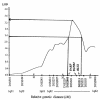PARP alleles within the linked chromosomal region are associated with systemic lupus erythematosus
- PMID: 10207165
- PMCID: PMC408279
- DOI: 10.1172/JCI5967
PARP alleles within the linked chromosomal region are associated with systemic lupus erythematosus
Abstract
Systemic lupus erythematosus (SLE) is an autoimmune disease characterized by various autoantibodies that recognize autoantigens displayed on the surface of cells undergoing apoptosis. The genetic contribution to SLE susceptibility has been widely recognized. We previously reported evidence for linkage to SLE of the human chromosome 1q41-q42 region and have now narrowed it from 15 to 5 cM in an extended sample using multipoint linkage analysis. Candidate genes within this region include (a) PARP, poly(ADP-ribose) polymerase, encoding a zinc-finger DNA-binding protein that is involved in DNA repair and apoptosis; (b) TGFB2, encoding a transforming growth factor that regulates cellular interactions and responses; and (c) HLX1, encoding a homeobox protein that may regulate T-cell development. Using a multiallelic, transmission-disequilibrium test (TDT), we found overall skewing of transmission of PARP alleles to affected offspring in 124 families (P = 0.00008), preferential transmission of a PARP allele to affected offspring (P = 0.0003), and lack of transmission to unaffected offspring (P = 0.004). Similar TDT analyses of TGFB2 and HLX1 polymorphisms yielded no evidence for association with SLE. These results suggest that PARP may be (or is close to) the susceptibility gene within the chromosome 1q41-q42 region linked to SLE.
Figures

Comment in
-
PARP alleles and SLE: failure to confirm association with disease susceptibility.J Clin Invest. 2000 Jun;105(11):1501-2. J Clin Invest. 2000. PMID: 10841503 No abstract available.
-
Searching for genes in complex diseases: lessons from systemic lupus erythematosus.J Clin Invest. 2000 Jun;105(11):1503-6. doi: 10.1172/JCI10266. J Clin Invest. 2000. PMID: 10841504 Free PMC article. No abstract available.
References
-
- Arnett, F.C., Jr. 1997. The genetics of human lupus. In Dubois’ lupus erythematosus, 5th edition. D.J. Wallace and B.H. Hahn, editors. Williams and Wilkins. Baltimore, MD. 77–117.
-
- Vyse TJ, Kotzin BL. Genetic susceptibility to systemic lupus erythematosus. Annu Rev Immunol. 1998;16:261–292. - PubMed
-
- Hochberg, M.D. 1997. The epidemiology of systemic lupus erythematosus. In Dubois’ lupus erythematosus, 5th edition. D.J. Wallace and B.H. Hahn, editors. Williams and Wilkins. Baltimore, MD. 49–65.
-
- Bowness P, et al. Hereditary C1q deficiency and systemic lupus erythematosus. Q J Med. 1994;87:455–464. - PubMed
Publication types
MeSH terms
Substances
Grants and funding
LinkOut - more resources
Full Text Sources
Other Literature Sources
Medical
Research Materials

